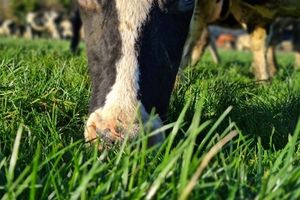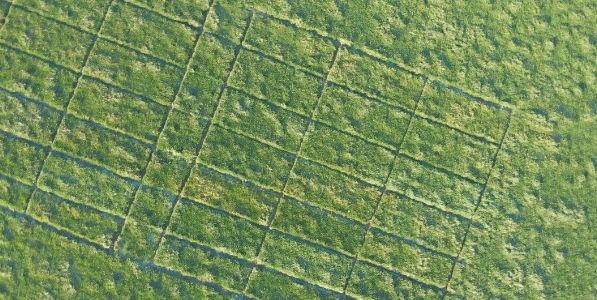Utilisation is the key to better efficiency
Irish milk and meat production systems are some of the most efficient in the world. Our efficiency advantage lies primarily in our ability to grow grass for grazing in very large quantities, thanks to favourable climatic conditions. Grazed grass is a relatively cheap feed for livestock, costing approximately €70/t DM, with a relatively low impact on the environment.
Video 1
Video 2
Video 3 For more on Clover click here
Video 4 For more on Multispecies and Agronomy Click Here
Video 5
Live Q&A with Dr. Thomas Moloney & John Enright
The profitability of Irish grass-based systems is not only dependent on how much grass is grown but how much grass is utilised. The amount of grass utilised is the grass that is consumed by the animal and used to produce milk and meat – this is the key driver of profitability.
Teagasc estimates that increasing the proportion of grazed grass in a dairy cow’s diet by 10% can lead to a 2.5 cent reduction in the cost of producing 1 litre of milk.
Furthermore, every additional 1 tonne of DM utilised per hectare can increase profitability by €181 per hectare and reduce GHG emissions intensity by 4%.
Grass utilisation on farms is quite variable, with utilisation figures ranging from 5 to 12 tonnes DM per hectare across production systems nationwide. Practical experience shows that certain perennial ryegrass varieties are easier to graze than others and this has been demonstrated in research trials at Teagasc too. Thus, variety and mixture selection when reseeding have a considerable effect on how much grass is utilised on farm.

The importance of grass utilisation and the variability between varieties has been acknowledged by introducing the Grazing Utilisation Trait to the Pasture Profit Index. This new trait gives a star rating to each variety that indicates how well a variety will be grazed. The ratings range from 1 – 5 stars with 5-star varieties grazed very well with greater rates of utilisation, and 1-star varieties grazed poorly.
At DLF we have begun our own on-farm variety grazing trial with 4 of our Grass Partners around the country. In this trial, we are examining the grazing performance of 21 different varieties to bring the best grazing varieties to the market. We are already seeing encouraging results from new varieties in seasonal and annual yield production as well as their grazing efficiency.

A notable trend to date is that, on average, tetraploid varieties are achieving much lower post-grazing residuals than diploid varieties. This suggests that including a higher proportion of tetraploid varieties in grazing mixtures should lead to better grazing efficiency and greater grass utilisation on farm.
On the back of our own research and with the PPI grazing utilisation star-ratings, we have created the unique DLF 4N Grazer, an all-tetraploid mixture designed to maximise grass utilisation on Irish farms. 4N Grazer combines two 5-star grazing varieties, Xenon and Aspect, with Nashota for a mixture that will hit all your grazing targets and provide quality forage throughout the season ensuring maximum grass utilisation.
Managing Grass for Maximum Utilisation
Apart from selecting the best grazing varieties to sow, there are a couple of management guidelines that should be followed to maximise grass utilisation. If we consider a grass plant, its life cycle can be divided into two distinct stages – the vegetative stage and the reproductive stage.
.jpg)
During the vegetative stage, the plant develops leaves to capture energy from the sun in preparation for the reproductive stage. In the vegetative stage the plant consists primarily of leaves that are highly digestible and rich in protein and energy. The perennial ryegrass plant will only ever have three living leaves at any one time. Once a fourth leaf appears, the first leaf will die, and the plant will enter the reproductive stage. During reproduction, the plant begins to lignify and produce a tough stem that will eventually support a seedhead. During this stage, the yield will greatly increase but this comes at a significant cost in quality.
The ideal time to graze a perennial ryegrass sward, therefore, is when most plants are at the 3-leaf stage. This strikes the best balance between yield and quality and will make utilisation by the cow easier. In the middle of the grass growing season, this third leaf typically appears in 18 – 21 days when pre-grazing covers are ~1,400kg DM/ha, hence the standard 3-week intervals in rotational grazing systems.
Grazing the sward down to a residual height of ~4cm ensures maximum utilisation of the forage grown and leaves enough of an energy reserve in the plant to allow it to recover from grazing and begin its growth cycle again. A post-grazing residual of ~4cm also prevents the accumulation of dead and stemmy material that is difficult to graze at the base of the sward. It is particularly important to hit this post-grazing target in the first couple of rotations as once this tough material is allowed to develop due to lax grazing its effect on quality will get progressively worse in each subsequent rotation. This will seriously impact grass utilisation during the grazing season.
The pre- and post-grazing sward height/cover are crucial elements in keeping the balance between grass yield and quality, with this balance determined by the 3-leaf principle of grass growth.
- 1 tonne of grass DM costs ~€70 to produce – relatively cheap compared to grass silage (€160/tonne DM) and concentrate (€250/tonne DM)
- Increasing the proportion of grazed grass in the diet by 10% can lead to a 2.5 cent reduction in the cost of producing 1 litre of milk
- Each additional tonne of DM utilised is worth approximately €181/ha
- Could reduce GHG emissions intensity by 4%
This series is brought to you by Dr. Thomas Moloney, DLF. If you would like to get more information whatsapp on 087 3961265
![]()
More research on grass utilistation


